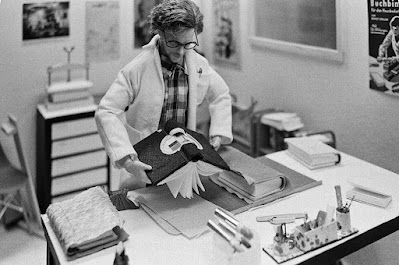Finally finding a time to meet, Minerva arrived with her books – a nice assortment of structures, and she was clearly proud of talking about them and how they were taught.
"Ummm, okay, they had a clay tablet literally thousands of years old paired with a simple notepad and an old Palm Pilot. After describing what they knew about the tablet's contents, they made us think about parallels to the modern items. Then, they asked us if these were books. I never really thought about what a book was and what made it one – also wondered about the point of the lesson, but it went on and on. Towards the end, I started to see the connections between the objects. My favorite part was feeling how these books felt in my hands."
"Yes, I've heard about these classes from 'the Boss' who presented many, hosted exhibits of the students' works, and even hired some. "But", said Fritz Otto, "let's look at what you brought, and you can tell me about them, including making them. Much more fun, for now."
"Next, I made this accordion thing from some of the same paper. I attached it to a simple cover. What I liked was that you could read it like a normal book, turning the pages, but also stretch it out to view the whole book. I dislike seeing books on display where they often can show only one spread. I could see exploring this one some more, and found examples online with cutting to create pop-ups or little pamphlets sewn in. The librarian described it as a gateway to 'freaky-foldies.'"
"Here is a simple pamphlet I made from a magazine article with lots of pictures of old papers from books. I kind of randomly folded them into folios (new word I learned) so that each page was different, even if from the same image. I titled it Codex.”
"In the class, they also gave us a list of websites, people to follow, and books that were more like manuals in case we wanted to learn more. That's how I found out about you," Minerva said.

%20sm.jpg)
%20sm.jpg)
%20sm.jpg)
%20sm.jpg)
%20sm.jpg)
%20sm.jpg)
%20sm.jpg)
%20sm.jpg)
%20sm.jpg)
%20sm.jpg)
%20sm.jpg)
%20sm.jpg)
%2022%20edited%20sm.jpg)
%2024%20edited%20sm.jpg)
%2026%20edited%20sm.jpg)
%2027%20edited%20sm.jpg)
%2030%20edited%20sm.jpg)
%2033%20edited%20sm.jpg)
%2034%20edited%20sm.jpg)
%20(12)%20edited%20sm.jpg)
%20(13)%20edited%20sm.jpg)
%20(16)%20edited%20sm.jpg)
%20(19)%20edited%20sm.jpg)
%20(20)%20edited%20sm.jpg)
%20(23)%20edited%20sm.jpg)
%20(25)%20edited%20sm.jpg)
%20(27)%20edited%20sm.jpg)
%20(30)%20edited%20sm.jpg)
%20(4)%20edited%20sm.jpg)
%20edit%20sm.jpg)
%20edit%20sm.jpg)
%20edit%20sm.jpg)
%20edit%20sm.jpg)
%20edit%20sm.jpg)
%20edit%20sm.jpg)
%20edit%20sm.jpg)
%20sm.jpg)
%20sm.jpg)













